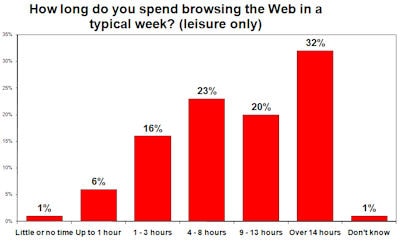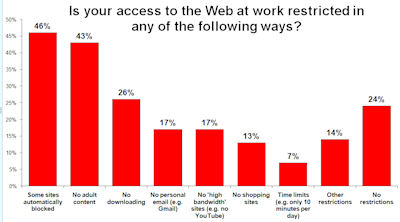With a mere one percent of the 2002 people surveyed saying that they spend ‘little or no time‘ browsing the internet, the increasing power of online communications to reach who you want, when you want, is impressive. The age group most likely to spend over 14 hours a week surfing online is 35 to 54 year olds, as 38 per cent of this demographic claim to do this, but even among the demographic that is the least-heavy online user, the 55-plus, 27 per cent are still browsing for over 14 hours a week.

Supplied by Opinium Research
People tend to browse online when they are at home (94 per cent), but 22 per cent also like to browse at work, and this figure rises to 32 per cent among 18 to 34 year olds, and 34 per cent for those based in London.
It is no wonder, therefore, that a growing amount of PR activity is now focused online, as so much media content is accessed this way. The media itself has transformed its output, with every leading broadcaster and publisher having a strong online presence. Even specialist magazines aimed at niche audiences appreciate the value of creating interesting online and digital editorial. Jen Campbell, communications executive at Future Publishing, describes how craft magazines have evolved; “Our craft magazines have always enjoyed a rich community aspect, but with the growth of online and digital arenas in the past few years, we’ve seen a real development in the way in which these enthusiasts interact with each other.
“With over half a million knitters online, it gives us access to a direct and personal dialogue to these niche enthusiasts in a way that is far more personal and intimate, and also encourages a dialogue amongst themselves also. For a campaign such as the Macmillan Comfort Blanket (where people knit squares for the charity Macmillan Cancer Support) the importance of online platforms should not be underestimated; it’ll give us a chance to make a real difference, and to extend on the possibilities afforded by traditional print media.”
However, when communicating with people in office hours, it must be taken into consideration that many will be facing limits as to how much they can do online. Our research shows that of those that can go online at work, 46 per cent have some sites automatically blocked, and 26 per cent are unable to do any downloading.

Supplied by Opinium Research
For many PR professionals working online, networking on social network sites such as Facebook and Twitter is an ideal way to communicate with key clients, contacts and journalists. Yet surprisingly, some journalists are not able to respond immediately to such online discussions, as they are restricted on their usage by their publishing companies.
A member of the editorial team at a leading publication at Centaur Media discusses the rules there: "We are allowed access to most sites, most the time. But social networking is only permitted at lunchtimes if you are a journalist, which can be a nuisance for some. We're also not allowed radio access and we can't access sports news either.”
An editor at media group Redactive says that editorial staff there are also not given full access to the internet, and that this is a “constant gripe“, adding, “We get access to Facebook and other social networking sites between 1pm and 2pm and outside normal working hours but that's it. They haven't yet cottoned on to Twitter so we're allowed to view that at any time. It's hugely frustrating as we have a Facebook group for the magazine and the institute that we can only access at lunchtime.”
Methodology
Opinion Research carried out 2002 online interviews for PRmoment in the UK, from Friday 10 July to Tuesday 14 July.
PR Masterclass: The Intersection of PR and GEO
Join PRmoment for a Masterclass featuring 10 of the industry’s foremost experts. You will walk away with a clear, actionable strategy for adapting your content to an AI-first search environment.
Taking place on Wednesday 25th February in London, both virtual and in person tickets are available.
If you enjoyed this article, sign up for free to our twice weekly editorial alert.
We have six email alerts in total - covering ESG, internal comms, PR jobs and events. Enter your email address below to find out more:









